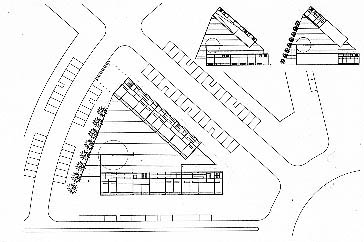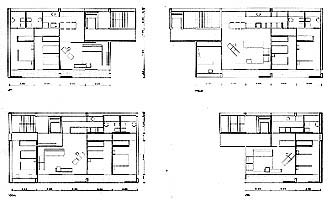
1st Preliminary proposals competition for housing convened by IVVSA
 |
I
Concurso de anteproyectos de vivienda convocado por el IVVVSA 1st Preliminary proposals competition for housing convened by IVVSA |
|||
| En Valencia, siendo las
10 horas del 14 de julio de 1.999, atendiendo las Bases que rigen el I Concurso de
Anteproyectos, aprobadas por acuerdo del Consejo de Administración del Instituto
Valenciano de Vivienda, S.A. en su sesión del 15 de febrero de 1.999, se constituye el
Jurado designado al efecto para dicho concurso, en la sede de la Conselleria de Obras
Públicas, Urbanismo y Transportes, sita en la Avda. Blasco Ibañez nº 50, con la
siguiente composición: Presidente: Ilmo. Sr. D. José María García Zarco, Vicepresidente del Consejo de Administración del I.V.V.,S.A. Vicepresidente: Por delegación del Gerente del I.V.V.,S.A., D. Juan Antonio Crehuet Marín, Dª Cecilia Ochoa Vera, arquitecta de Promoción de Suelo del I.V.V.,S.A. Vocales: D. Carlos Llopis Verdú, arquitecto de Promoción de Viviendas del I.V.V.,S.A. Dª María Jesús Rodríguez Ortiz, arquitecta de Promoción de Suelo del I.V.V.,S.A.D. Alberto Sanchis Cuesta, arquitecto designado por la Dirección General de Arquitectura y Vivienda de la COPUT. Actúa como Secretaria, con voz y sin voto, Dª Milagros López Sanjosé, en su calidad de Asesora Jurídica del I.V.V.,S.A. Asiste el Presidente del Colegio Territorial de Arquitectos de Alicante, D. Antonio Mari Mellado que participa como invitado a la presente sesión por parte del Sr. Presidente del Jurado. El Sr. Presidente declara abierta la sesión, procediéndose al estudio de las distintas propuestas presentadas a los 3 emplazamientos objeto de este Concurso y tras las oportunas deliberaciones se emite el siguiente FALLO: Emplazamiento 1, Parcela R-4 del Plan Parcial del Sector R-5 "Río Seco" en Castellón, para un nº aproximado de 40 viviendas. Se procede a conceder por unanimidad: PREMIO Se valora la resolución de la implantación en el solar propuesto con la mínima intervención, eliminando los conflictos de acuerdo entre las alineaciones existentes. Se valora asimismo la calidad espacial y arquitectónica de las viviendas basada en el sistema de relaciones establecido con los espacios exteriores, y estructuración funcional, sin renunciar a la flexibilidad. Igualmente, el Jurado acuerda conceder la siguiente mención: Se valora la aportación del estudio minucioso sobre la versatilidad de la distribución de la vivienda, consiguiendo la adaptación a diferentes necesidades de los usuarios, transgrediendo con valentía la rigidez de los estereotipos al uso. Emplazamiento 2: Parcela F6 de la U.A.-2 del PGOU de San Vicente del Raspeig, para un nº aproximado de 52 viviendas. El jurado estima conceder por unanimidad el siguiente: PREMIO Se premia esta propuesta por un planteamiento que consigue racionalizar y simplificar una solución renovadora en un solar de compleja geometría, alejándose del esquema habitual de máxima profundidad que obliga a recurrir a los patios de luces como única solución. Se destaca asimismo un estudio tipológico de viviendas contundente y claro, posibilitando una célula habitacional donde prima el contacto con el exterior, el orden compositivo y funcional y las múltiples posibilidades de circulación y relación espacial entre sus piezas. Igualmente el Jurado acuerda hacer las siguientes menciones: Se valora por el jurado la búsqueda de soluciones no convencionales en el campo de la vivienda protegida, a través de un exhaustivo estudio de la sección que permite la creación de espacios sugerentes con patios abiertos y terrazas jardín propios de cada vivienda, así como el intento de aplicar dicho estudio al solar propuesto. Se destaca la interpretación geométrica y modular frente a la arbitraria geometría resultante de una previa parcelación a través de la colmatación total del espacio configurando un sistema continuo de llenos y vacios. Emplazamiento 3: Parcela D del Sector APD/4 "Rabasa" en Alicante. El jurado acuerda conceder por unanimidad el siguiente: PREMIO Se valora la reflexión sobre las nuevas formas de habitar, dando respuesta a diversos temas de debate, la versatilidad e individualidad de la vivienda frente al bloque, el control climático en relación a la dualidad interior-exterior, la calidad espacial y claridad compositiva de las viviendas, la libertad en el esquema de agrupación y la respuesta a un entorno unifamiliar y de límite urbano. Finalmente el Jurado quiso dejar constancia de la calidad de los trabajos presentados tanto en lo que se refiere a las soluciones propuestas como a la propia presentación. Y no habiendo mas que tratar el presidente da por finalizada la sesión siendo las 15 horas del día señalado en el encabezamiento, suspendiéndose la reunión por unos minutos con el fin de que por secretaría se redacte el acta de la misma, siendo aprobada y suscrita por todos los miembros del jurado. |
In pursuance of
the Rules governing the 1st Preliminary Proposals Competition approved by the
Board of Directors of the Instituto Valenciano de la Vivienda S.A. [hereinafter I.V.V.,
S.A.] at the meeting held on 15th February 1999, the Jury designated to judge
the said competition was constituted in Valencia at 10 a.m. on 14th July 1999
at the head offices of the Regional Government’s Public Works, Urbanism and Transport
Ministry [hereinafter COPUT], at Avda. Blasco Ibañez no. 50, as follows: Chairman: José María García Zarco, Vice-Chairman of I.V.V., S.A. Vice-chairman: Cecilia Ochoa Vera, I.V.V., S.A. Land Development architect, delegated by Juan Antonio Crehuet Marín, Manager of I.V.V., S.A. Members: Carlos Llopis Verdú, I.V.V., S.A. Housing Development architect, María Jesús Rodríguez Ortiz, I.V.V., S.A. Land Development architect, Alberto Sanchis Cuesta, architect designated by the COPUT Architecture and Housing Directorate General. Secretary, with the right to speak but not to vote: Milagros López Sanjosé, as Legal Advisor to I.V.V., S.A. Also present was Antonio Mari Mellado, Chairman of the Territorial College of Architects of Alicante, who participated in this meeting at the invitation of the Chairman of the Jury. The chairman declared the meeting open and the Jury proceeded to study the various proposals submitted for the 3 sites covered by this Competition. Following due deliberation the following DECISION was taken: Site 1: Plot R-4 of the Partial Plan for Sector R-5 "Río Seco" of Castellón, to an approximate number of 40 housing units. The Jury proceeded unanimously to award: PRIZE The Jury valued the solution given to the siting in the proposed plot which involves minimum intervention and eliminates conflicts of agreement between the existing alignments. The spatial and architectural quality of the buildings based on their system of relationships with the external spaces was also valued, as was their being structured functionally but without renouncing flexibility. The Jury also agreed to award the following honourable mention: The meticulous study of versatility in the distribution of the dwelling, which achieves adaptation to the different needs of the users and courageously transgresses the rigidity of prevailing stereotypes, is valued for its contribution. Site 2: Plot F6 of U.A.-2 of the General Urban Zoning Plan of San Vicente del Raspeig, to an approximate number of 52 housing units. The Jury unanimously agreed to award the following PRIZE The prize was awarded to this proposal for an approach that manages to rationalise and simplify a renovative solution for a plot of complex geometry, departing from the habitual pattern of maximum depth which makes it necessary to resort to air wells as the only solution. The Jury also drew attention to the clear and forcible typological study of housing units which makes it possible to achieve a dwelling cell where the emphasis is placed on contact with the exterior, compositional and functional order and the multiple possibilities of circulation and spatial relationship between the rooms. The Jury also agreed to award the following honourable mentions: The Jury valued the search for unconventional solutions in the field of subsidised housing by means of a comprehensive study of the section that enables inspiring spaces to be created, with open courtyards and individual terrace gardens for each dwelling unit, and the attempt to apply the said study to the proposed plot. Attention was drawn to the geometrical, modular interpretation that fills the entire space to shape a continuous system of full and empty volumes, as opposed to the arbitrary geometry resulting from its previous division into separate plots. Site 3: Plot D of Sector APD/4, "Rabasa", of Alicante The Jury unanimously agreed to award the following PRIZE This proposal’s reflection on new ways of dwelling is valued. It provides answers to various subjects of debate, the versatility and individuality of dwellings as opposed to the block, climate control in relation to the duality of interior-exterior, the spatial quality and compositional clarity of the dwellings, freedom in the manner of grouping these and the response to a single-family environment on the edge of a city. Lastly, the Jury wished to place on record the quality of the works submitted, both in the solutions they propose and in the presentation of the submissions. There being no further business, the chairman declared the meeting closed at 3 p.m. on the date herein before. The meeting adjourned for some minutes to enable the secretary to draw up the minutes, which were then approved and signed by all the members of the Jury. |
Uno, dos, tres  |
Enrique
Fernández-Vivancos González, Juan Deltell Pastor Colaboradores: Isabel Vernia Canuto, José Luis Delgado Urdanibia, Clara Elena Mejia Vallejo, Mª José García Peñalver Uno, dos, tres Parcela R-4 del Plan parcial sector R-5 "Rio Seco" de Castellón. Una parcela con una geometría tan condicionante, requiere una solución que logre evitar los conflictos. Se trata el problema del ángulo no como esquina construida de un volumen, sino como la relación entre planos en deslizamiento que no llegan a encontrarse. Se busca una pieza de vivienda con el menor ancho posible, que sea capaz de minimizar el conflicto de las dos alineaciones en la esquina, ampliando el espacio abierto central. La irrenunciable calidad espacial y arquitectónica de las viviendas propuestas, residirá en el sistema de relaciones establecido con los espacios exteriores. El proyecto se concibe para admitir un proceso de prefabricación destinado a reducir el costo de la mano de obra en la construcción. Los materiales propuestos, estructura de hormigón, ladrillo de hormigón blanco, carpinterías de aluminio lacado y una protección solar a base de paneles correderos y lamas de tablero fenólico; buscan aunar las condiciones de economía, durabilidad, fácil reposición y la necesaria dignidad de la edificación. |
Enrique
Fernández-Vivancos González, Juan Deltell Pastor Assisted by: Isabel Vernia Canuto, José Luis Delgado Urdanibia, Clara Elena Mejia Vallejo, Mª José García Peñalver Uno, dos, tres Parcela R-4 del Plan parcial sector R-5 "Rio Seco" de Castellón. A plot with such a demanding geometry requires a solution that will manage to avoid conflicts. The problem of the angle is not treated as the constructed corner of a volume but as the relationship between sliding planes that never meet. A housing component of the least possible width is sought in order to minimise the conflict between the two alignments at the corner while enlarging the central open area. The spatial and architectural quality of the dwellings is irrenunciable. It will reside in the system of relations with the exterior spaces. The project is designed to allow for prefabrication in order to reduce the cost of the labour employed on the building. The proposed materials (concrete structure, white concrete brick, lacquered aluminium joinery and protection from the sun based on sliding panels and phenol board slats) attempt to combine economy, durability, eas e of replacement and the necessary dignity of the building. |